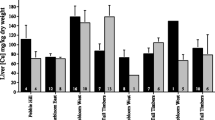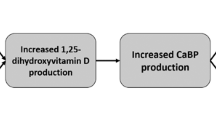Abstract
The concentrations of lead, cadmium, and manganese in the tissues of cattle egrets (Bubulcus ibis) and laughing gulls (Larus atricilla) gathered from the Galveston Bay region of Texas were compared, to determine if different patterns of accumulation exist. Their levels in these species were within the range reported for other bird species. Lead levels in bone were comparable, but gulls had more lead in brain, kidney and liver tissues than the egrets, which suggested a higher rate of accumulation or exposure. Due to their high abundance and comparable positions in the estuarine and terrestrial food webs, it is suggested thatBubulcus ibis andLarus atricilla may serve as convenient biological indicators to monitor potentially toxic substances in these ecosystems.
Similar content being viewed by others
References
Anderlini, V. C., P. G. Connors, R. W. Riselrough, and J. H. Martin: Concentrations of heavy metals in some Antarctic and North American sea birds. Proc. of Coll. on Cons. Prob. Antarctica.1, 49 (1971).
Atkinson, R. L., J. W. Bradley, J. R. Couch, and J. H. Quisenberry: Effect of various levels of manganese on the reproductive performance of turkeys. Poultry Sci.46, 472 (1967).
Bagley, G. E., and L. N. Locke: The occurrence of lead in tissues of wild birds. Bull. Environ. Contam. Toxicol.2, 297 (1967).
Bowles, J. H.: Lead poisoning in ducks. Auk.25, 312 (1908).
Dixon, W. J.: B.M.D., Biomedical computer program. Berkeley: University of California Los Angeles Press, (1973).
Environmental Protection Agency: Report on pollution affecting shellfish harvesting in Galveston Bay, Texas. Dallas, Texas Environmental Protection Agency Water Quality Office, Division of Field Investigations-Denver Center and South Central Region (1971).
Faggan, J. E.: Potential dilemma. Methods of meeting automotive exhaust standards of the Clean Air Act of 1970. Environ. Health Perspect.10, 11 (1975).
Finley, M. T., M. P. Dieter, and L. N. Locke: Lead in tissues of mallard ducks dosed with two types of lead shot. Bull. Environ. Contam. Toxicol.16, 261 (1976).
Getz, L. L., A. W. Haney, R. W. Larimore, J. W. McNurney, H. V. Leland, P. W. Price, G. L. Rolfe, R. L. Wortman, J. L. Hudson, R. L. Solomon, and K. A. Reinbold: Transport and distribution in a watershed ecosystem.Lead in the Environment. NSF/RA-770214. Chpt. 6, 105 (1977).
Horowitz, A., and B. J. Presley: Trace metal concentrations and partitioning in Zooplankton, neuston, and benthos from the south Texas outer continental shelf. Arch. Environ. Contam. Toxicol.5, 241 (1977).
Jenkins, C.: Feral pigeon (Columba liva) as an indicator of atmospheric lead pollution. C.R. Hebd. Seances Acad. Sci., Ser. D.281, 1187 (1975).
Kelsall, J. P., W. J. Pannekoek, and R. Burton: Variability in the chemical content of waterfowl plumage. Can. J. Zool.53, 1379 (1975).
Kjellstrom, T., B. Lind, L. Linnman, and G. Nordberg: A comparative study on methodology for cadmium analysis of grain with an application to pollution evaluation. Environ. Res.8, 92 (1974).
Leach, R. M., Jr., A. M. Muenster, and E. M. Wien: Studies on the role of manganese in bone formation. II. Effect upon chondroitin sulfate synthesis in chick epiphyseal cartilage. Arch. Biochem. Biophys.133, 22 (1969).
Locke, L. N., and G. E. Bagley: Lead poisoning in a sample of Maryland mourning doves. J. Wildlife Mgmt.31(3), 515 (1967).
Longcore, J. R., L. N. Locke, G. E. Bagley, and R. Andrews: Significance of lead residues in mallard tissues. U.S. Fish and Wildlife Service, Special Scientific Report—Wildlife No. 182, Washington, DC (1974).
Martin, M. H., and P. J. Coughtrey: Preliminary observations on the levels of cadmium in a contaminated environment. Chemosphere3, 155 (1975).
Martin, W. E., and P. R. Nickerson: Mercury, lead, cadmium, and arsenic residues in starlings—1971. Pesticides Monitoring J.7(1), 67 (1973).
Meranger, J. C., and E. Sommers: Determination of heavy metal concentration in seafood by atomic absorption spectrophotometry. Bull. Environ. Contam. Toxicol.3, 360 (1968).
Munoz, R. V., C. S. Hacker, and T. F. Gesell: Environmentally acquired lead in the laughing gull,Larus atricilla. J. Wildl. Dis.12, 139 (1976).
Ohi, G., H. Seki, K. Akihama, and H. Yagu: The pigeon, a sensor of air pollution. Bull. Environ. Contam. Toxicol.12, 92 (1974).
Pier, S. M.: The role of heavy metals in human health. Texas Reports on Biology and Medicine33(1), 85 (1975).
Seth, T. D., L. N. Agarwal, N. K. Satija, and M. Z. Hasan: The effect of lead and cadmium on liver, kidney, and brain levels on cadmium, copper, lead, manganese, and zinc, and on erythrocyte ALA-D activity in mice. Bull. Environ. Contam. Toxicol.16, 190 (1976).
Sims, R. R., Jr., and B. J. Presley: Heavy metal concentrations in organisms from an actively dredged Texas Bay. Bull. Environ. Contam. Toxicol.16, 520 (1976).
Smith, R. G., Jr., and H. L. Windom: Analytical handbook for the determination of arsenic, cadmium, cobalt, copper, iron, lead, manganese, mercury, nickel, silver and zinc in the marine and estuarine environment. Georgia Marine Science Center, University System of Georgia. Tech. Rep. Ser. No. 72-6 (1972).
Tansy, M. G., and R. P. Roth: Pigeons: A new role in air pollution. J. Air Poll. Contr. Assn.20, 307 (1970).
Waldron, H. A., and D. Stöfen: Subclinical Lead Poisoning. London: Academic Press (1974).
Westemeier, R. L.: Apparent lead poisoning in a wild bobwhite. Wilson Bull.78(4), 471 (1966).
White, D. H., R. J. Bean, and J. R. Longcore: Nationwide residues of mercury, lead, cadmium, and arsenic in starlings. Pesticides Monitoring J.11(1), 35 (1977).
Author information
Authors and Affiliations
Rights and permissions
About this article
Cite this article
Hulse, M., Mahoney, J.S., Schroder, G.D. et al. Environmentally acquired lead, cadmium, and manganese in the cattle egret,Bubulcus ibis, and the laughing gull,Larus atricilla . Arch. Environ. Contam. Toxicol. 9, 65–77 (1980). https://doi.org/10.1007/BF01055500
Received:
Accepted:
Issue Date:
DOI: https://doi.org/10.1007/BF01055500




